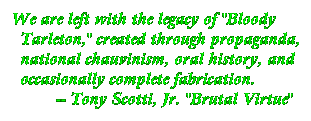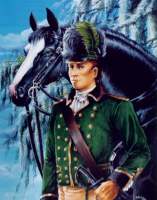


|

|

It is human nature to want to fit the past into tidy storybook patterns, to reduce it to tales with clear-cut morals populated by heroes and villains. But if we search into the history behind the idealized heroes of myth, legend and folklore, more often than not we find only flawed and ordinary individuals, struggling to survive the sweep of events. King Richard III is commonly remembered as a monster, not because evidence supports his villainy but because the history of his reign was recorded by his enemies. Was Lucrezia Borgia a cold-hearted poisoner? Many people casually "know" that she was, yet history reveals a vastly gentler version of this much-maligned lady.
Years ago, in the pages of a novel set during the American Revolution, I stumbled across a less famous victim of the power of folklore: Lieutenant Colonel Banastre Tarleton, Commandant of the British Legion. Nicknamed "the Green Dragoon" by his twentieth-century biographer1, Tarleton served under Lord Cornwallis during the Revolution's Southern Campaign, where his aggressive fighting style and gift for fluid, hit-and-run warfare earned him a dark place in local legend. Predictably, he was presented as the novel's "villain," but I found him so entertaining that I was drawn to investigate the history behind the myths of "Bloody Ban."

|
The young man who waited, buried and often forgotten in the pages of historical research, had little in common with the black-hearted villain immortalized in Revolutionary War myths as "the Butcher of the Carolinas." A devil-may-care charmer, the real Ban Tarleton quickly became one of my favorite historical figures, and so he remains. He was a fearless and ferocious cavalry leader, capable of showing his enemies both chivalry and ruthlessness. Away from the battlefield, he was a witty, hyper-sociable little rogue who made friends by the carriageload. (After the war, that list of friends grew to include many of his former enemies such as the Duc de Lauzun, Lafayette, Thaddeus Kosciusko and possibly even Thomas Jefferson.)
While Tarleton was far from a saint, he was just as far from being a monster, and he deserves a better accounting than he is normally given by popular "history." Most recently, his reputation has been tarred-and-feathered yet again by the movie The Patriot, whose producers cite him as their template for their elegant but antisocial villain, Colonel William Tavington. As a fictional movie foe, Will Tavington is an utter delight, and I was blown away by the quality of Jason Isaacs' performance in the role. Tavington, however, has virtually nothing in common with Banastre Tarleton! There are vague similarities between their names, they each show plenty of panache when leading a cavalry column, and they share a fondness for fluffy black hats. Beyond that, the resemblance between them is nothing more than a figment of the Hollywood imagination. [Historian Dr. M. M. Gilchrist, AKA Doc M, has more to say on this subject.]

|
After so much this historical and contemporary abuse, it seems only fair to give the Green Dragoon some fair and friendly representation. This site is affectionately dedicated to Banastre, his friends and colleagues, and the soldiers of the British Legion.
Site contents are permanently under construction, but at the moment you'll find:
 [more information] |
I updated the site once a month when I first started it, but this schedule
has slowed down now that it has matured and I've gotten caught up on the backlog of material.
Nowadays, the schedule is pretty irregular. Newly posted articles are flagged by
![]() on the
NavBar to the left of this introductory page. I try to mention the more interesting additions and
mods to already existing articles in the
updates log.
on the
NavBar to the left of this introductory page. I try to mention the more interesting additions and
mods to already existing articles in the
updates log.
I'd like to offer many thanks to all of the people who have helped with research, contributions, tidbits of information, corrections, opinions and encouragement: Doc M (Dr. Marianne M. Gilchrist), Holley Calmes, Janie Cheaney, Heather Bruton, Leanne Shaw, Max Lindenman, Peter Tarleton, Don Gara, John Morrow, Adam Tarleton, Lytton Jarman, Barb S., Todd W. Braisted, Jay Callaham, Mark Nichipor, Bill Braham, Nan Cole, Linden Salter, Stac Rinner, Steve Haller, Michael Scoggins (of the York County Historical Society), Peter Hovenden-Jones, John Robertson, Irene Sniffin (of the Huntington, NY Historical Society), Nikki Palumbo, Guy Breakingbury, Carolyn Jack, Alex Crichton, Nicholas Graham (of the Massachusetts Historical Society), Gretchen Runnalls, Alexandra Smith, John G. Tarleton, Bruce Lander, David Kennett, Neil Pearce, Bob Bond, Dr. Joseph Kane and Barbara Smith (both of the Tarleton Day School), Thomas Edsall, Christina Georgiou, Tracy Smith, Diane P. Rofini (of the Chester County Historical Society), Kate Jenks, Karen from the Net, John Pearson, Kevin Derby, John Maass, Caroline ("Ima Fish"), Charles Baxley (of Historic Camden), Sue Adams, Brett Witt, Bob Kight, Christopher Bryant, Greg Eanes, John, Elizabeth Gibbons, Dr. Gregory Urwin, Don Hagist, Janet Blood (of the William L. Clements Library), David Redden (of Sotheby's, New York), Dan Shaw, Michael Estacio, Tracy LeClere and Scott Miskimon.
The information here is as historically accurate as I can make it, but in keeping with the tone of Ban's own madcap life, there is silliness mixed in, starting with our title. Find out why we are "Oatmeal for the Foxhounds".
1 The nickname "The Green Dragoon" dates back only as far as Robert D. Bass's biography in the 1950s. See the trivia section for a discussion of Tarleton's various nicknames. [ back ]
|
| Last updated by the Webmaster on October 3, 2006 |